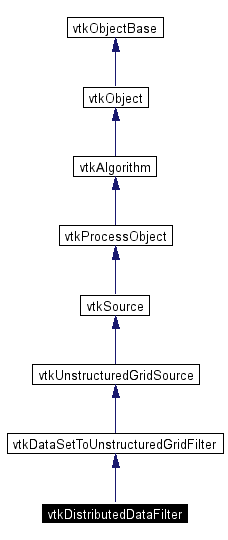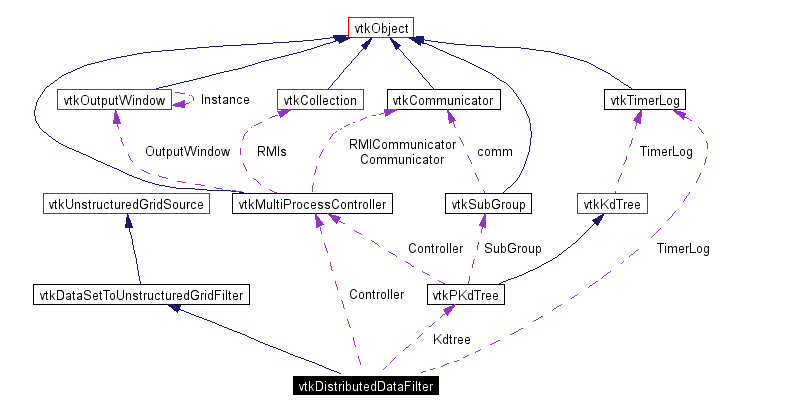vtkDistributedDataFilter Class Reference
#include <vtkDistributedDataFilter.h>
Inheritance diagram for vtkDistributedDataFilter:
 [legend]
[legend]Collaboration diagram for vtkDistributedDataFilter:
 [legend]List of all members.
[legend]List of all members.
Detailed Description
Distribute data among processors.
This filter redistributes data among processors in a parallel application into spatially contiguous vtkUnstructuredGrids. The execution model anticipated is that all processes read in part of a large vtkDataSet. Each process sets the input of filter to be that DataSet. When executed, this filter builds in parallel a k-d tree, decomposing the space occupied by the distributed DataSet into spatial regions. It assigns each spatial region to a processor. The data is then redistributed and the output is a single vtkUnstructuredGrid containing the cells in the process' assigned regions.
- Warning:
- The Execute() method must be called by all processes in the parallel application, or it will hang. If you are not certain that your pipeline will execute identically on all processors, you may want to use this filter in an explicit execution mode.
- See also:
- vtkKdTree vtkPKdTree
- Created by:
-
- CVS contributions (if > 5%):
- Law, Charles (83%)
- Fisk, Lee Ann (15%)
- CVS logs (CVSweb):
/Parallel/vtkDistributedDataFilter.cxx)/Parallel/vtkDistributedDataFilter.h)
- Tests:
- vtkDistributedDataFilter (Tests)
Definition at line 76 of file vtkDistributedDataFilter.h.
Member Enumeration Documentation
|
|
- Enumeration values:
-
| ASSIGN_TO_ONE_REGION |
|
| ASSIGN_TO_ALL_INTERSECTING_REGIONS |
|
| SPLIT_BOUNDARY_CELLS |
|
Definition at line 166 of file vtkDistributedDataFilter.h. |
Constructor & Destructor Documentation
| vtkDistributedDataFilter::vtkDistributedDataFilter |
( |
|
) |
[protected] |
|
Member Function Documentation
| void vtkDistributedDataFilter::PrintSelf |
( |
ostream & |
os, |
|
|
vtkIndent |
indent |
|
) |
[virtual] |
|
|
|
Methods invoked by print to print information about the object including superclasses. Typically not called by the user (use Print() instead) but used in the hierarchical print process to combine the output of several classes.
Reimplemented from vtkDataSetToUnstructuredGridFilter. |
| void vtkDistributedDataFilter::PrintTiming |
( |
ostream & |
os, |
|
|
vtkIndent |
indent |
|
) |
|
|
|
|
Create an object with Debug turned off, modified time initialized to zero, and reference counting on.
Reimplemented from vtkAlgorithm. |
|
|
Set/Get the communicator object |
|
|
Set/Get the communicator object |
| virtual void vtkDistributedDataFilter::SetGlobalNodeIdArrayName |
( |
const char * |
|
) |
[virtual] |
|
|
|
It is desirable to have a field array of global node IDs for two reasons: 1. When merging together sub grids that were distributed across processors, global node IDs can be used to remove duplicate points and significantly reduce the size of the resulting output grid. If no such array is available, D3 will use a tolerance to merge points, which is much slower. 2. If ghost cells have been requested, D3 requires a global node ID array in order to request and transfer ghost cells in parallel among the processors. If there is no global node ID array, D3 will in parallel create a global node ID array, and the time to do this can be significant. If you know the name of a global node ID array in the input dataset, set that name with this method. If you leave it unset, D3 will search the input data set for certain common names of global node ID arrays. If none is found, and ghost cells have been requested, D3 will create a temporary global node ID array before aquiring ghost cells. |
| virtual void vtkDistributedDataFilter::SetGlobalElementIdArrayName |
( |
const char * |
|
) |
[virtual] |
|
|
|
It is also desirable to have global element IDs. However, if they don't exist D3 can create them relatively quickly. Set the name of the global element ID array if you have it. If it is not set, D3 will search for it using common names. If still not found, D3 will create a temporary array of global element IDs. |
| virtual void vtkDistributedDataFilter::RetainKdtreeOn |
( |
|
) |
[virtual] |
|
|
|
When this filter executes, it creates a vtkPKdTree (K-d tree) data structure in parallel which divides the total distributed data set into spatial regions. The K-d tree object also creates tables describing which processes have data for which regions. Only then does this filter redistribute the data according to the region assignment scheme. By default, the K-d tree structure and it's associated tables are deleted after the filter executes. If you anticipate changing only the region assignment scheme (input is unchanged) and explicitly re-executing, then RetainKdTreeOn, and the K-d tree structure and tables will be saved. Then, when you re-execute, this filter will skip the k-d tree build phase and go straight to redistributing the data according to region assignment. See vtkPKdTree for more information about region assignment. |
| virtual void vtkDistributedDataFilter::RetainKdtreeOff |
( |
|
) |
[virtual] |
|
| virtual int vtkDistributedDataFilter::GetRetainKdtree |
( |
|
) |
[virtual] |
|
| virtual void vtkDistributedDataFilter::SetRetainKdtree |
( |
int |
|
) |
[virtual] |
|
| vtkPKdTree* vtkDistributedDataFilter::GetKdtree |
( |
|
) |
|
|
|
|
Get a pointer to the parallel k-d tree object. Required for changing default behavior for region assignment, changing default depth of tree, or other tree building default parameters. See vtkPKdTree and vtkKdTree for more information about these options. |
| virtual void vtkDistributedDataFilter::IncludeAllIntersectingCellsOn |
( |
|
) |
[virtual] |
|
|
|
Each cell in the data set is associated with one of the spatial regions of the k-d tree decomposition. In particular, the cell belongs to the region that it's centroid lies in. When the new vtkUnstructuredGrid is created, by default it is composed of the cells associated with the region(s) assigned to this process. If you also want it to contain cells that intersect these regions, but have their centroid elsewhere, then set this variable on. By default it is off. |
| virtual void vtkDistributedDataFilter::IncludeAllIntersectingCellsOff |
( |
|
) |
[virtual] |
|
| virtual int vtkDistributedDataFilter::GetIncludeAllIntersectingCells |
( |
|
) |
[virtual] |
|
| virtual void vtkDistributedDataFilter::SetIncludeAllIntersectingCells |
( |
int |
|
) |
[virtual] |
|
| virtual void vtkDistributedDataFilter::ClipCellsOn |
( |
|
) |
[virtual] |
|
|
|
Set this variable if you want the cells of the output vtkUnstructuredGrid to be clipped to the spatial region boundaries. By default this is off. |
| virtual void vtkDistributedDataFilter::ClipCellsOff |
( |
|
) |
[virtual] |
|
| virtual int vtkDistributedDataFilter::GetClipCells |
( |
|
) |
[virtual] |
|
| virtual void vtkDistributedDataFilter::SetClipCells |
( |
int |
|
) |
[virtual] |
|
| void vtkDistributedDataFilter::SetBoundaryMode |
( |
int |
mode |
) |
|
|
|
|
Handling of ClipCells and IncludeAllIntersectingCells. |
| void vtkDistributedDataFilter::SetBoundaryModeToAssignToOneRegion |
( |
|
) |
[inline] |
|
| void vtkDistributedDataFilter::SetBoundaryModeToAssignToAllIntersectingRegions |
( |
|
) |
[inline] |
|
| void vtkDistributedDataFilter::SetBoundaryModeToSplitBoundaryCells |
( |
|
) |
[inline] |
|
| int vtkDistributedDataFilter::GetBoundaryMode |
( |
|
) |
|
|
|
|
Handling of ClipCells and IncludeAllIntersectingCells. |
| virtual void vtkDistributedDataFilter::ComputeInputUpdateExtents |
( |
vtkDataObject * |
output |
) |
[virtual] |
|
| virtual void vtkDistributedDataFilter::UseMinimalMemoryOn |
( |
|
) |
[virtual] |
|
|
|
This class does a great deal of all-to-all communication when exchanging portions of data sets and building new sub grids. By default it will do fast communication. It can instead use communication routines that use the least possible amount of memory, but these are slower. Set this option ON to choose these latter routines. |
| virtual void vtkDistributedDataFilter::UseMinimalMemoryOff |
( |
|
) |
[virtual] |
|
| virtual int vtkDistributedDataFilter::GetUseMinimalMemory |
( |
|
) |
[virtual] |
|
| virtual void vtkDistributedDataFilter::SetUseMinimalMemory |
( |
int |
|
) |
[virtual] |
|
| virtual void vtkDistributedDataFilter::TimingOn |
( |
|
) |
[virtual] |
|
|
|
Turn on collection of timing data |
| virtual void vtkDistributedDataFilter::TimingOff |
( |
|
) |
[virtual] |
|
| virtual void vtkDistributedDataFilter::SetTiming |
( |
int |
|
) |
[virtual] |
|
| virtual int vtkDistributedDataFilter::GetTiming |
( |
|
) |
[virtual] |
|
| unsigned long vtkDistributedDataFilter::GetMTime |
( |
|
) |
[virtual] |
|
|
|
Consider the MTime of the KdTree.
Reimplemented from vtkObject. |
| void vtkDistributedDataFilter::AssignBoundaryCellsToOneRegionOn |
( |
|
) |
[protected] |
|
|
|
Another way to set ClipCells and IncludeAllIntersectingCells. AssignBoundaryCellsToOneRegion turns off both ClipCells and IncludeAllIntersectingCells. Each cell will be included in exactly one process' output unstructured grid. |
| void vtkDistributedDataFilter::AssignBoundaryCellsToOneRegionOff |
( |
|
) |
[protected] |
|
| void vtkDistributedDataFilter::SetAssignBoundaryCellsToOneRegion |
( |
int |
val |
) |
[protected] |
|
| void vtkDistributedDataFilter::AssignBoundaryCellsToAllIntersectingRegionsOn |
( |
|
) |
[protected] |
|
|
|
Another way to set ClipCells and IncludeAllIntersectingCells. AssignBoundaryCellsToAllIntersectingRegions turns off ClipCells turns on IncludeAllIntersectingCells. A cell will be included in the output unstructured grid built for every region that it intersects. If a cell intersects two process' spatial regions, both processes will have that cell in their output grid. |
| void vtkDistributedDataFilter::AssignBoundaryCellsToAllIntersectingRegionsOff |
( |
|
) |
[protected] |
|
| void vtkDistributedDataFilter::SetAssignBoundaryCellsToAllIntersectingRegions |
( |
int |
val |
) |
[protected] |
|
| void vtkDistributedDataFilter::DivideBoundaryCellsOn |
( |
|
) |
[protected] |
|
|
|
Another way to set ClipCells and IncludeAllIntersectingCells. DivideBoundaryCells turns on both ClipCells and IncludeAllIntersectingCells. A cell that straddles a processor boundary will be split along the boundary, with each process getting the portion of the cell that lies in it's spatial region. |
| void vtkDistributedDataFilter::DivideBoundaryCellsOff |
( |
|
) |
[protected] |
|
| void vtkDistributedDataFilter::SetDivideBoundaryCells |
( |
int |
val |
) |
[protected] |
|
| void vtkDistributedDataFilter::Execute |
( |
|
) |
[protected, virtual] |
|
| void vtkDistributedDataFilter::SingleProcessExecute |
( |
|
) |
[protected] |
|
| void vtkDistributedDataFilter::ExecuteInformation |
( |
|
) |
[protected, virtual] |
|
The documentation for this class was generated from the following file:

